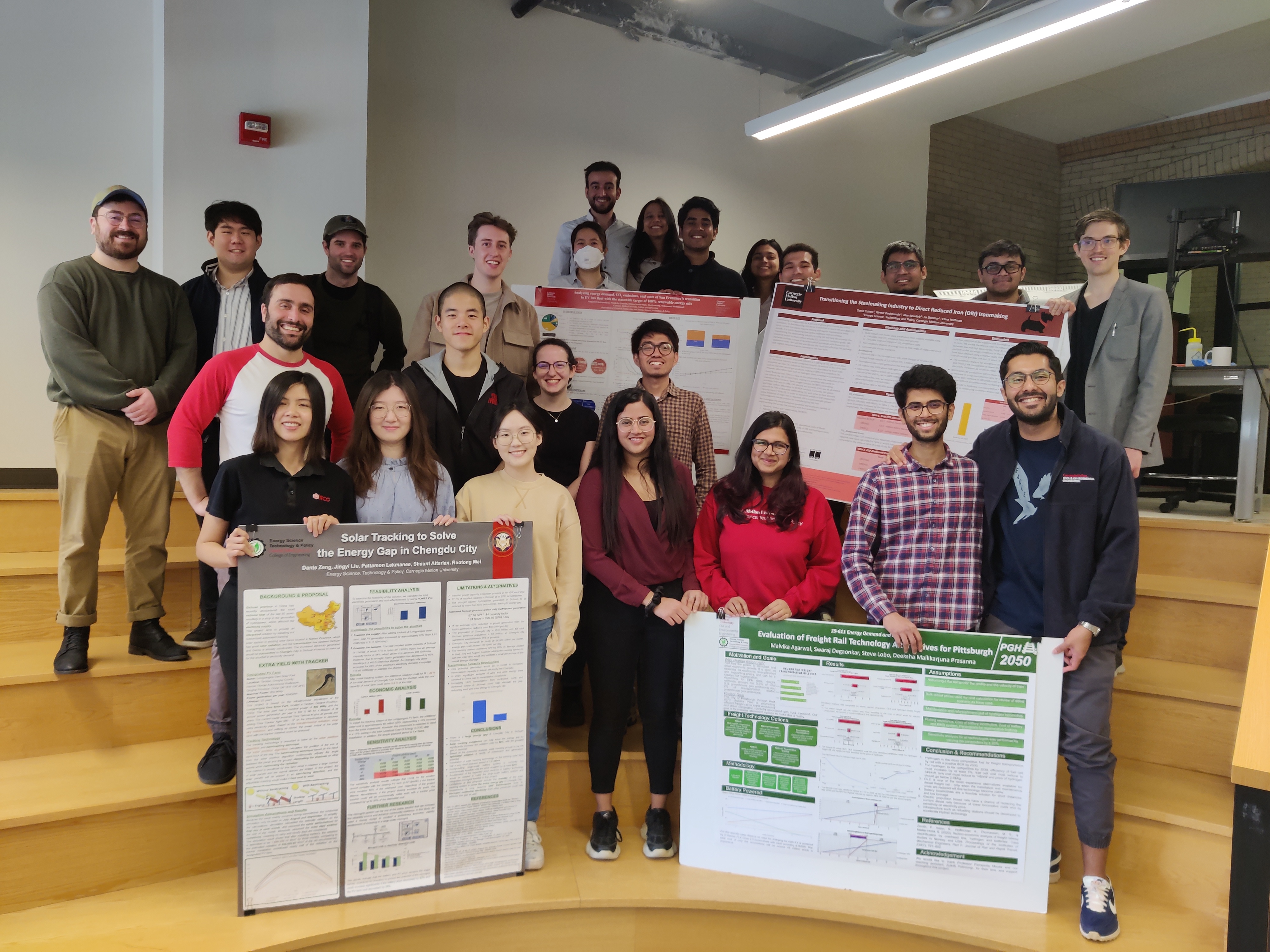
Students Present Final Posters in EST&P's Core Class
By Nicole Rihn
On Thursday, March 2nd the students of EST&P’s third core course, Energy Demand and Utilization, presented their final posters to the class. The course is taught by Panayiotis (Panos) Moutis, one of EST&P’s core faculty members. “The aim of the course is to understand how energy has been historically defining the human condition, used as a measure of growth and framing the discussion about our effects to the world as an intertwined ecosystem. By understanding how long-term decisions and policies work, we learn how we are part of the global outlook and if/how we can change that,” says Moutis.
Current EST&P student, Zulkifli Palinrungi, is the teaching assistant for this course. “Energy is more than just a mere commodity; it's a vital part of our daily lives that shapes the world we live in. This course offers a comprehensive view of the energy sector, allowing us to grasp the current energy challenges faced by different countries and regions and the interconnection between them,” said Palinrungi. “As the students worked on their energy demand and utilization poster project, I provided them with guidance and feedback to help them refine their message and ensure that their visual elements were both engaging and effective. As a teaching assistant for this class, I had the privilege of witnessing many innovative ideas take shape and was able to help them into a cohesive and well-explained solution.”
Below, each poster group is listed, along with the title and summary of their project.
- Nirmit Deshpande (EST&P), Jai Shekhar (EST&P), David Cohen (EST&P), Alex Newkirk (EST&P): "Transitioning the Steelmaking Industry to Direct Reduced Iron (DRI) Ironmaking".
"The course overall focused on what humans actually use energy to do: rather than generating voltages and heat, what we use heat and volts to accomplish. Our poster focused on the energy intensive industrial sector. Most of the world's steel is made with iron produced in a blast furnace using refined coal as fuel. Steel can also be produced from melt scrap in an electric furnace. These furnaces can also use a feedstock called direct-reduced-iron which does not use coal. We built a techno-economic model to compare the life-cycle costs and carbon emissions of a greenfield DRI-EAF vs a blast furnace in the United States. We found that given present natural gas, electricity, and coal prices, in the US market DRI-EAF steelmaking has a lower net present cost than the blast furnace alternative."
- Deeksha Mallikarjuna Prasanna (CEE), Malvika Agarwal (EST&P), Steve Lobo (CEE), Swaraj Sanjeev Degaonkar (EST&P): "Evaluation of Freight Rail Technology Alternatives for Pittsburgh".
"Energy Demand and Utilization focuses on the demand side of the energy spectrum. It provides a comprehensive outlook on the energy demand of different economic sectors such as residential, commercial, industrial, transportation and the food chain and an understanding of important demand related concepts such as energy efficiency and the rebound effect. The course culminated with a final poster presentation. Our team's poster, titled 'Evaluation of Freight Rail Technology Alternatives for Pittsburgh', focused on the Pennsylvania Main Line rail route running from Pittsburgh to Philadelphia via Harrisburg (570 km) traveling at an average speed of 50 kmph. Our aim was to help the City of Pittsburgh evaluate different options to bring efficient movement of rail in the city in accordance with its 2070 Mobility Vision Plan. The study determined the energy consumed and fuel consumption associated with diesel powered trains base case and compared it to Overhead Line Electrification (OLE), electric propulsion, lithium ion battery and hydrogen fuel cells. Further, we compared the net present value (NPV) and the benefit to cost ratio (BCR) for these technologies and performed sensitivity analysis. Two cases were considered under hydrogen as a possible fuel for future freight transportation - first, without refueling and second, with refueling. Hydrogen is the most cost competitive fuel and will have a BCR>1 by 2030 for both cases."
- Sampriti Chattopadhyay (CHE), Pratiksha Ganesan (EST&P), Sriram Sankar Hari (EST&P), Marilyn Kung (EST&P), Mohammad Mohammadi (EST&P): "Analyzing Energy Demand; CO2 emissions and costs for San Francisco's transition to EV bus Fleet with statewide transition to 100% renewable energy mix".
"San Francisco aims to electrify its entire bus fleet by 2040 and the city has various policies and incentives to boost BEB (Battery Electric Bus) sales, to enhance ridership and increase the dependability and frequency of buses. However, the city is facing a few challenges due to outdated technology and range limitations. The San Francisco Municipal Transportation Authority (SFMTA) has proactively been pursuing green transportation technologies, and has the greenest transit system among all major cities in North America. They account for a mere 2% of GHG emissions in the transportation sector. In order to assess the robustness of current policy, we examine five different scenarios that mix and match 100% electrification of the fleet and how clean the grid is. Our analysis suggests that electrification of the fleet by 2030 (rather than 2040) would help drastically reduce emissions as compared to the city’s current goals. We also conclude that faster adoption of EV buses would reduce more emissions than using 100% clean energy sources (though both are important to achieve), and therefore recommend policymakers procure funding and adopt BEBs as quickly as possible."
- Shaunt Attarian (EST&P), Ruotong Wei (EST&P), Jingyi Liu (EST&P), Dante Zeng (EST&P), Pattamon Lekmanee (EST&P): "Solar Tracking to Solve the Energy Gap in Chengdu City."
"We explored the potential of solar tracking technology to address the energy gap faced by Chengdu City during the summer of 2022. With a significant drop in hydropower generation capacity and a surge in electricity demand due to extreme heat and low precipitation, solar tracking offers an optimized solution. Our study includes an economic analysis of solar tracking and its potential to increase radiation yield by up to 80%, particularly in summer. Additionally, we investigate the potential of future research in large-scale battery storage systems and investing in transmission to Chengdu City to increase grid resilience. Through case studies and real-world examples, we comprehensively understand the opportunities and limitations associated with implementing solar tracking technology to address energy gaps caused by extreme weather conditions."
- Jaih Hunter-Hill (EPP), MacLeod Morehouse (Heinz), Reed Callan (Heinz), Kyu Yeol Paik (CHE): “Addressing the Challenge of Residential Heating”.
"In the Energy Demand & Utilization course, we tackle multiple issues involved with energy including industrial, transportation, and commercial. The course constantly challenges its students to, as Professor Moutis emphasizes, “know your crisis”. In our attempt to understand a part of this crisis, we decided to look at residential heating, as it is one of the primary drivers of energy consumption in the United States."
"Moreover, we evaluated residential heating and the impact that certain heating systems have on the environment and consumer’s wallets. The poster we pulled together titled “Addressing the Challenge of Residential Heating” compiled our analysis of the financial and carbon impact of Radiant Floor Heating and Heat Pumps across several regions within the United States. We took numerous factors into consideration including the average temperature of each region, the state energy prices, and the costs of each heating method’s installation."
"We found that heat pumps perform much better than radiant floor heating from a lifetime savings and carbon emissions perspective. That said, timing for when to replace one’s system is key, with heat pumps only making sense when a homeowner is ready to replace their system or at the end of life of their current system."
- Natali Khalife (CHE), Philippe Schicker (Heinz), Diana Warren (CEE), Lily Hanig (EPP): "Steel vs Aluminum in Automotive Production".
"The course Energy Demand & Utilization delves into the evolution of human energy needs and their variations across nations, while also analyzing current demand and future projections. The course primarily focuses on the technological advancements used in various sectors, including housing, commerce, food, industry, and transportation. For the final project of the course, each group was required to present a poster that evaluate or propose a solution aimed at reducing the energy demand of a sector. The posters described the proposed solution in detail, accompanied by theoretical evaluations of the potential savings, implementation costs, ease of deployment, and estimated emissions saved as tools to evaluate the viability of the solution."
"Our project focused on the transportation industry, which heavily relies on cars that are primarily composed of steel. Since steel is a heavy material, steel cars emit significant amount of greenhouse gas emissions during the use phase. To reduce these emissions, we explored the use of aluminum as a viable alternative for car frames. Although aluminum is a lighter material, enabling electric vehicles to have longer driving ranges and less fuel consumption, it is more expensive than steel. To determine the most cost-effective and less environmentally impactful solution, we conducted a life-cycle assessment that considered not only the direct costs but also the externalities such as the social cost of carbon. Based on this analysis, we evaluated the potential benefits of government interventions, such as subsidies or tax credits."
